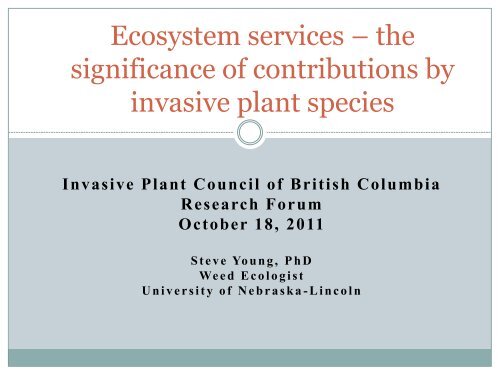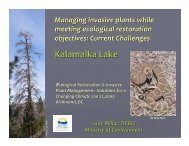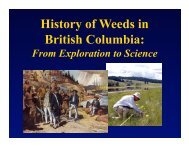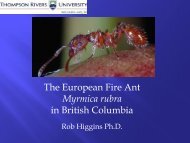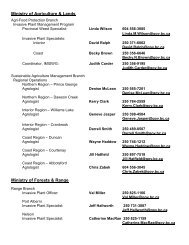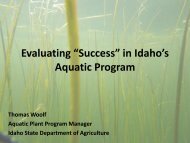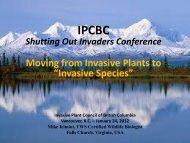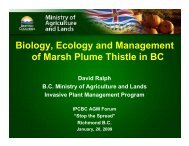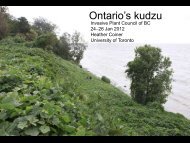Ecosystem services and invasive plants - Invasive Plant Council of BC
Ecosystem services and invasive plants - Invasive Plant Council of BC
Ecosystem services and invasive plants - Invasive Plant Council of BC
Create successful ePaper yourself
Turn your PDF publications into a flip-book with our unique Google optimized e-Paper software.
<strong>Ecosystem</strong> <strong>services</strong> – the<br />
significance <strong>of</strong> contributions by<br />
<strong>invasive</strong> plant species<br />
<strong>Invasive</strong> <strong>Plant</strong> <strong>Council</strong> <strong>of</strong> British Columbia<br />
Research Forum<br />
October 18, 2011<br />
S t e v e Yo u n g , P h D<br />
We e d E c o l o g i s t<br />
U n i v e r s i t y o f N e b r a s k a - L i n c o l n
Outline<br />
• Discuss <strong>invasive</strong> plant species impacts<br />
• Define ecosystem <strong>services</strong><br />
• Present information on:<br />
◦ A theoretical framework for assessing <strong>invasive</strong> plant<br />
species <strong>and</strong> ecosystem <strong>services</strong><br />
◦ The practical considerations for reducing <strong>invasive</strong><br />
plant species impacts on ecosystem <strong>services</strong><br />
• Summary
Bromus tectorum<br />
Spartina alterniflora<br />
Tamarix spp.<br />
Myrica faya<br />
Genista<br />
monspessulana
<strong>Invasive</strong> plant species<br />
• Present in nearly every region <strong>and</strong> most habitat types<br />
Fraction <strong>of</strong> flora that is exotic for 184 sites around the world, broken down by:<br />
Region<br />
Biome<br />
Source: Lonsdale 1999
<strong>Invasive</strong> plant species<br />
• Present in nearly every region <strong>and</strong> most habitat types<br />
• Economic impact > $120 billion per year in US<br />
(Pimental et al. 2005)
<strong>Invasive</strong> plant species<br />
• Present in nearly every region <strong>and</strong> most habitat types<br />
• Economic impact > $120 billion per year in US<br />
(Pimental et al. 2005)<br />
• Invasion frequencies<br />
are increasing
<strong>Ecosystem</strong> Services
Biodiversity<br />
<strong>Ecosystem</strong> <strong>services</strong><br />
• Millennium ecosystem assessment (2005)<br />
Supporting<br />
Nutrient cycling, Seed dispersal, Primary Productivity<br />
Provisioning<br />
Food, fresh<br />
water, pharmas,<br />
energy, fiber<br />
Regulation<br />
C sequestration,<br />
flood control,<br />
pest control<br />
Cultural<br />
Aesthetics,<br />
heritage,<br />
recreation,<br />
spiritual<br />
• MANY categories declining under current<br />
scenarios
Outline<br />
• Discuss <strong>invasive</strong> plant species impacts<br />
• Define ecosystem <strong>services</strong><br />
• Present information on:<br />
◦ A theoretical framework for assessing <strong>invasive</strong> plant<br />
species <strong>and</strong> ecosystem <strong>services</strong><br />
◦ The practical considerations for reducing <strong>invasive</strong><br />
plant species impacts on ecosystem <strong>services</strong><br />
• Summary
How do we assess ecosystem <strong>services</strong><br />
• Indicators must be:<br />
◦ Representative<br />
◦ Reliable<br />
◦ Feasible<br />
• Current assessments: “…because ecosystem <strong>services</strong> can<br />
be difficult to measure directly, scientists have tended to<br />
use l<strong>and</strong> use ⁄ l<strong>and</strong> cover as a proxy for the provision<br />
<strong>of</strong> <strong>services</strong> even though the relationships between l<strong>and</strong> use ⁄<br />
l<strong>and</strong> cover <strong>and</strong> service provision are largely untested<br />
for most <strong>services</strong> in most regions <strong>of</strong> the world.”<br />
(Bennett et al. 2009)
What do we need to underst<strong>and</strong> to manage<br />
ecosystem <strong>services</strong><br />
• Who are the key ecosystem service providers<br />
• What are the components <strong>of</strong> community structure<br />
that influence function at l<strong>and</strong>scape level (e.g.<br />
compensatory mechanisms)<br />
• What are the key environmental factors<br />
• What are the spatio-temporal scales over which<br />
providers <strong>and</strong> <strong>services</strong> operate<br />
Kremen 2005
% precip available<br />
Mark <strong>and</strong> Dickinson 2008
Water quantity Forage production Carbon storage Flood control<br />
High precip- ET climate, NPP, <strong>Plant</strong> biomass l<strong>and</strong> use,<br />
forage quality, (AG+ BG) veg. type<br />
grazing tolerance<br />
distribution<br />
sales livestock<br />
products<br />
Low Chan et al. 2006
<strong>Ecosystem</strong> processes that impact water supply<br />
Braumann et al 2007
How are ecosystem <strong>services</strong> different from<br />
functions<br />
• Services <strong>of</strong>ten integrate across multiple ecosystem<br />
functions <strong>and</strong> attributes<br />
• Emphasis on scale & location<br />
• Emphasis on multiple <strong>services</strong> <strong>and</strong> trade<strong>of</strong>fs<br />
• Distribution <strong>of</strong> <strong>services</strong> depends on distribution <strong>of</strong><br />
functions as well as human dem<strong>and</strong>s
Assessment <strong>and</strong> prediction <strong>of</strong> ecosystem <strong>services</strong><br />
impacted by IPS<br />
• Can we use ecosystem functions as proxies for <strong>services</strong><br />
• How strong are our broad generalizations about the<br />
ecosystem impacts <strong>of</strong> invaders<br />
• How do we move beyond these generalizations to consider:<br />
◦ Context- dependence: environment<br />
◦ Abundance<br />
◦ Community interactions<br />
◦ Temporal scale<br />
◦ Spatial scale<br />
Heterogeneity within vegetation types<br />
Heterogeneity across l<strong>and</strong>scape<br />
Scale at which <strong>services</strong> are regulated<br />
Scale at which ecosystem functions are needed for human use<br />
• How do we integrate all <strong>of</strong> these factors
Assessment <strong>and</strong> prediction <strong>of</strong> ecosystem <strong>services</strong><br />
impacted by IPS<br />
• Can we use ecosystem functions as proxies for<br />
<strong>services</strong><br />
◦ We have a good underst<strong>and</strong>ing <strong>of</strong> many species effects on<br />
ecosystem functions.<br />
◦ <strong>Ecosystem</strong> functions used as proxies for <strong>services</strong><br />
Must consider integration <strong>of</strong> component functions over space <strong>and</strong><br />
time<br />
◦ Predictions based on functions an improvement over current<br />
assessment techniques, especially when incorporating the<br />
mechanisms
How do invaders impact <strong>services</strong><br />
Charles & Dukes<br />
2007
Assessment <strong>and</strong> prediction <strong>of</strong> ecosystem <strong>services</strong><br />
impacted by IPS<br />
• Can we use ecosystem functions as proxies for <strong>services</strong><br />
• How strong are our broad generalizations about the<br />
ecosystem impacts <strong>of</strong> invaders<br />
• How do we move beyond these generalizations to<br />
consider:<br />
◦ Context- dependence: environment<br />
◦ Abundance<br />
◦ Community interactions<br />
◦ Temporal scale<br />
◦ Spatial scale<br />
Heterogeneity within vegetation types<br />
Heterogeneity across l<strong>and</strong>scape<br />
Scale at which <strong>services</strong> are regulated<br />
Scale at which ecosystem functions are needed for human use<br />
• How do we integrate all <strong>of</strong> these factors
Moving from “all invaders” to functional-type<br />
generalizations<br />
• Invaders that provide novel functional types have<br />
large impacts<br />
◦ N fixers (increase decomposition, nitrogen cycling)<br />
◦ Woody invasion into grassl<strong>and</strong>s (tend to decrease water<br />
provision, increase carbon sequestration)<br />
◦ High biomass producers near waterways (WUE <strong>and</strong><br />
spread rate compared to native vegetation)
Soil C impacts <strong>of</strong> woody invasion into grassl<strong>and</strong>s<br />
Increase C<br />
Decrease C<br />
Jackson et al 2002
What about less obvious changes<br />
(when invasions are similar vegetation structure)
What about less obvious changes<br />
(water use by „vegetation‟)<br />
Johns 1989
Russian olive<br />
‣Seasonal ET<br />
(May 1 Through September 1, 2005)<br />
‣26.7 Inches OR 2.23 Acre-feet Water, AVERAGE<br />
Equals 23.8 Gallons Water Per <strong>Plant</strong> Per Day*<br />
‣Seasonal LOW Of 11.8 Inches Water<br />
10.5 Gallons Water Per <strong>Plant</strong> Per Day*<br />
‣Seasonal HIGH Of 41.5 Inches Water<br />
36.9 Gallons Water Per <strong>Plant</strong> Per Day*<br />
OR<br />
OR<br />
Hergert et al., 2010
Saltcedar<br />
‣Seasonal ET<br />
(May 1 Through September 1, 2005)<br />
‣26.8 Inches OR 2.23 Acre-feet Water, AVERAGE<br />
Equals 21.6 Gallons Water Per <strong>Plant</strong> Per Day*<br />
‣Seasonal LOW Of 13.8 Inches Water<br />
11.1 Gallons Water Per <strong>Plant</strong> Per Day*<br />
‣Seasonal HIGH Of 37.8 Inches Water<br />
30.5 Gallons Water Per <strong>Plant</strong> Per Day*<br />
OR<br />
OR<br />
Hergert et al., 2010
Assessment <strong>and</strong> prediction <strong>of</strong> ecosystem <strong>services</strong><br />
impacted by IPS<br />
• How strong are our broad generalizations about the<br />
ecosystem impacts <strong>of</strong> invaders<br />
◦ Broad generalizations are a good first step<br />
◦ Management <strong>and</strong> updated theory should be based on<br />
Measurements <strong>of</strong> individual invaders across space <strong>and</strong> time<br />
Collectively, these measurements can build a better predictive<br />
framework
Assessment <strong>and</strong> prediction <strong>of</strong> ecosystem <strong>services</strong><br />
impacted by IPS<br />
• Can we use ecosystem functions as proxies for <strong>services</strong><br />
• How strong are our broad generalizations about the<br />
ecosystem impacts <strong>of</strong> invaders<br />
• How do we move beyond these generalizations to<br />
consider:<br />
◦ Context- dependence: environment<br />
◦ Abundance<br />
◦ Community interactions<br />
◦ Temporal scale<br />
◦ Spatial scale<br />
Heterogeneity within vegetation types<br />
Heterogeneity across l<strong>and</strong>scape<br />
Scale at which <strong>services</strong> are regulated<br />
Scale at which ecosystem functions are needed for human use<br />
• How do we integrate all <strong>of</strong> these factors
Assessment <strong>and</strong> prediction <strong>of</strong> ecosystem <strong>services</strong><br />
impacted by IPS<br />
• How do we move beyond these generalizations to<br />
consider:<br />
◦ Context- dependence: environment<br />
Different traits regulate functions in different environments<br />
A given species alters its traits in response to its environment<br />
◦ Abundance/community interactions<br />
<strong>Ecosystem</strong> effects vary with abundance (linear vs. non-linear)<br />
Impact <strong>of</strong> abundance depends on similarity in function
What density does a plant need to be at to have an ecosystem effect<br />
Fyles & Fyles1993<br />
100% fir 100% alder 100% fir 100% alder
Non-natives impact soils even at less than<br />
3% <strong>of</strong> community biomass<br />
Invaders present<br />
Soil C (%) .27 + .024 .2 + .008<br />
Microbial activity (μg<br />
CO 2 -C g −1 soil h −1 )<br />
.56 + .14 .28 + .08<br />
Invaders removed<br />
Natives + invaders Natives only Invaders only<br />
Peltzer et<br />
al. 2009
Assessment <strong>and</strong> prediction <strong>of</strong> ecosystem <strong>services</strong><br />
impacted by IPS<br />
• How do we move beyond these generalizations to<br />
consider:<br />
◦ Context- dependence: environment<br />
Different traits regulate functions in different environments<br />
A given species alters its traits in response to its environment<br />
◦ Abundance/community interactions<br />
<strong>Ecosystem</strong> effects vary with abundance (linear vs. non-linear)<br />
Impact <strong>of</strong> abundance depends on similarity in function<br />
◦ Spatiotemporal scale<br />
Heterogeneity within vegetation types <strong>and</strong> across l<strong>and</strong>scapes<br />
Scales at which <strong>services</strong> <strong>and</strong> functions are regulated <strong>and</strong> needed<br />
for human use, respectively
Spatiotemporal scales<br />
• Variability<br />
◦ Annual (e.g. cheatgrass NPP varies 10-fold year to year)<br />
◦ Seasonal<br />
• “Hot moments”<br />
• Thresholds<br />
• Directional<br />
shifts over<br />
time<br />
MEA 2005
• Different<br />
patches <strong>of</strong><br />
l<strong>and</strong>scape<br />
provide<br />
different<br />
<strong>services</strong><br />
• Invasions<br />
may alter<br />
<strong>services</strong> by<br />
making<br />
l<strong>and</strong>scape<br />
more<br />
homogenous<br />
• Location <strong>of</strong><br />
invasion on<br />
l<strong>and</strong>scape<br />
matters<br />
MEA 2005
Assessment <strong>and</strong> prediction <strong>of</strong> ecosystem <strong>services</strong><br />
impacted by IPS<br />
• Requires integration across complexity :<br />
◦ The effects <strong>of</strong> invaders on ecosystem functions changes with<br />
environment, abundance, community interactions, space <strong>and</strong><br />
time.<br />
◦ Current trait-based predictive frameworks can be exp<strong>and</strong>ed,<br />
<strong>and</strong> coupled with l<strong>and</strong>scape theory to predict these variations
Outline<br />
• Discuss <strong>invasive</strong> plant species impacts<br />
• Define ecosystem <strong>services</strong><br />
• Present information on:<br />
◦ A theoretical framework for assessing <strong>invasive</strong> plant<br />
species <strong>and</strong> ecosystem <strong>services</strong><br />
◦ The practical considerations for reducing <strong>invasive</strong><br />
plant species impacts on ecosystem <strong>services</strong><br />
• Summary
The practicality <strong>of</strong> <strong>invasive</strong> plant species <strong>and</strong><br />
ecosystem <strong>services</strong><br />
• How have <strong>invasive</strong> species affected ecosystem<br />
<strong>services</strong><br />
• Can we restore ecosystem <strong>services</strong> following<br />
invasion
The practicality <strong>of</strong> <strong>invasive</strong> plant species <strong>and</strong><br />
ecosystem <strong>services</strong><br />
• Not all exotic species are equal – need to prioritize<br />
• Species impacts driven by species traits <strong>and</strong> habitat<br />
characteristics, among other factors<br />
• Removal is <strong>of</strong>ten not enough - legacies
Significant community changes<br />
California grassl<strong>and</strong>s<br />
Semi-arid shrubl<strong>and</strong>s<br />
Freshwater wetl<strong>and</strong>s<br />
Forest understories
Biodiversity<br />
• Wilcove et al. (1998) - >49% <strong>of</strong> listed species in U.S.<br />
affected by <strong>invasive</strong> species<br />
• Gurevich <strong>and</strong> Padilla (2004) – Multiple factors:<br />
l<strong>and</strong>-use, <strong>invasive</strong> species, among others, can‟t be<br />
separated<br />
• Sax <strong>and</strong> Gaines (2008) – Species invasions may<br />
increase biodiversity<br />
• The role <strong>of</strong> <strong>invasive</strong> species in extinctions <strong>of</strong> <strong>plants</strong><br />
may be overstated, but significant shifts are<br />
occurring in community composition
Supporting <strong>services</strong><br />
• Provide indirect benefits to humans, through other<br />
<strong>services</strong><br />
• <strong>Invasive</strong> species <strong>of</strong>ten (not always) increase net<br />
primary productivity <strong>and</strong> net N cycling rates<br />
• <strong>Invasive</strong> plant species have increased some measures,<br />
but this is not necessarily beneficial
Provisioning <strong>services</strong><br />
Water hyacinth in Lake Victoria, Kenya<br />
Agricultural<br />
run-<strong>of</strong>f <strong>and</strong><br />
nutrient-rich<br />
sediment<br />
• 1998: >20,000 ha<br />
• 2005 – Nearly<br />
absent<br />
• 2006 – Reinvasion<br />
following heavy<br />
rains <strong>and</strong> nutrient<br />
influx<br />
Source: NASA
Provisioning <strong>services</strong><br />
Water hyacinth in Lake Victoria, Kenya<br />
Agricultural<br />
run-<strong>of</strong>f <strong>and</strong><br />
nutrient-rich<br />
sediment<br />
• 1998: >20,000 ha<br />
• 2005 – Nearly<br />
absent<br />
• 2006 – Reinvasion<br />
following heavy<br />
rains <strong>and</strong> nutrient<br />
influx<br />
• Consequences:<br />
“Dead zones” <strong>and</strong><br />
loss <strong>of</strong> fishing<br />
productivity<br />
Source: NASA
Provisioning <strong>services</strong><br />
• Food, fresh water, pharmaceutical products, energy,<br />
fiber<br />
• Agricultural pests – weeds, pathogens, diseases<br />
• Weeds decrease agricultural productivity by ~12%<br />
• Degrade pasture l<strong>and</strong> – e.g. leafy spurge, St. John‟s<br />
wort<br />
• Well-established negative impacts <strong>of</strong> <strong>invasive</strong> plant<br />
species on provisioning <strong>services</strong>
Regulating <strong>services</strong><br />
• C sequestration<br />
Meta-analysis <strong>of</strong> effects <strong>of</strong> invasion on ecosystem C<br />
pools (Liao et al. 2008)<br />
Carbon pool<br />
% increase in<br />
pool size<br />
(native <br />
exotic)<br />
Shoots 133 ± 2 84<br />
Roots 5 ± 3 60<br />
Litter 49 ± 9 16<br />
Soil 6 ± 1 83<br />
Soil microbes 34 ± 6 14<br />
n
Regulating <strong>services</strong><br />
• C sequestration<br />
• Flood control - Tamarix spp. in southwest
Tamarix spp.<br />
• Shrub or small tree<br />
introduced from Eurasia<br />
• Invades riparian habitat<br />
• Widespread in arid <strong>and</strong><br />
semi-arid North America
Tamarix spp. - Impacts<br />
• Displaces native vegetation<br />
• Increases fire frequency<br />
• Increases water transpiration – depleting<br />
groundwater<br />
- Consumes 3000-4500 m 3 ha -1 yr -1 more water than native veg<br />
- (Annual precipitation < 4500 m 3 ha -1 yr -1 )<br />
• Increases flooding, erosion rates
Regulating <strong>services</strong><br />
• C sequestration<br />
• Flood control - Tamarix spp. in southwest<br />
• A number <strong>of</strong> examples for <strong>plants</strong>, but better<br />
documentation exists for all <strong>invasive</strong> species
Lupines in California (native)<br />
What is aesthetic
What is aesthetic<br />
Lupines in California (native)<br />
Purple loosestrife in CT (exotic)
Cultural <strong>services</strong><br />
• Aesthetic beauty, heritage, recreation<br />
• Maybe the most difficult to quantify or generalize,<br />
but local, state <strong>and</strong> national policy initiatives<br />
indicate that <strong>invasive</strong> [plant] species threaten<br />
things widely accepted as important (e.g., boating,<br />
hiking, fishing, bird watching).
The practicality <strong>of</strong> <strong>invasive</strong> plant species <strong>and</strong><br />
ecosystem <strong>services</strong><br />
• How have <strong>invasive</strong> species affected ecosystem<br />
<strong>services</strong><br />
- Significant effects on all categories<br />
• Can we restore ecosystem <strong>services</strong> following<br />
invasion
The practicality <strong>of</strong> <strong>invasive</strong> plant species <strong>and</strong><br />
ecosystem <strong>services</strong><br />
• How have <strong>invasive</strong> species affected ecosystem<br />
<strong>services</strong><br />
- Significant effects on all categories<br />
• Can we restore ecosystem <strong>services</strong> following<br />
invasion
Restoring ecosystem <strong>services</strong><br />
• Removal <strong>of</strong> <strong>invasive</strong> species – Manual, chemical,<br />
biological methods
Restoring ecosystem <strong>services</strong><br />
• Removal <strong>of</strong> <strong>invasive</strong> species – manual, chemical,<br />
biological methods<br />
• Removal alone is not enough<br />
◦ Legacies <strong>of</strong> invasion exist<br />
◦ Legacies can have an impact on ecosystem <strong>services</strong> (restoring<br />
<strong>and</strong> maintaining)<br />
◦ Legacies established during <strong>invasive</strong> plant species occupancy<br />
◦ Legacy effects retained (long) after <strong>invasive</strong> plant species have<br />
vacated
Legacies <strong>of</strong> <strong>invasive</strong> species<br />
• Community legacies<br />
• Changes in nutrient or resource “pools”
Pools vs. fluxes<br />
• Nitrogen cycle:<br />
◦ Pools: Vegetation, soil organic matter, inorganic N<br />
◦ Fluxes: <strong>Plant</strong> uptake, mineralization, nitrification, leaching
Legacies <strong>of</strong> <strong>invasive</strong> species<br />
• Community legacies<br />
• Changes in nutrient or resource “pools”<br />
- N-fixers increase soil N pools<br />
- California non-native grasses increase N leaching losses<br />
- Tamarix increases sedimentation, narrows stream channels
Legacies <strong>of</strong> <strong>invasive</strong> species<br />
• Community legacies<br />
• Changes in nutrient or resource “pools”<br />
- N-fixers increase soil N stocks<br />
- California non-native grasses increase N leaching losses<br />
- Tamarix increases sedimentation, narrows stream channels<br />
• Changes in soil biota
Changing soil biotic communities<br />
• Soil from garlic mustard<br />
st<strong>and</strong>s has lower<br />
mycorrhizal fungi<br />
colonization<br />
• Soil from garlic mustard<br />
st<strong>and</strong>s has lower tree<br />
seedling growth<br />
Stinson et al. 2006
Changing soil biotic communities<br />
• Soil from garlic mustard<br />
st<strong>and</strong>s has lower<br />
mycorrhizal fungi<br />
colonization<br />
• Soil from garlic mustard<br />
st<strong>and</strong>s has lower tree<br />
seedling growth<br />
• Mechanism – Garlic<br />
mustard disrupts plantfungi<br />
mutualism Stinson et al. 2006
Legacies <strong>of</strong> <strong>invasive</strong> species<br />
• Community legacies<br />
• Changes in nutrient or resource “pools”<br />
- N-fixers increase soil N stocks<br />
- California non-native grasses increase N leaching losses<br />
- Tamarix increases sedimentation, narrows stream channels<br />
• Changes in soil biota<br />
• To be successful, restoration must consider such<br />
legacies <strong>and</strong> their ‘costs’ to the ecosystem
The practicality <strong>of</strong> <strong>invasive</strong> plant species <strong>and</strong><br />
ecosystem <strong>services</strong><br />
• How have <strong>invasive</strong> species affected ecosystem<br />
<strong>services</strong><br />
- Significant effects on all categories<br />
• Can we restore ecosystem <strong>services</strong> following<br />
invasion<br />
- Yes, but must do more than just remove target<br />
species<br />
- Legacies <strong>of</strong> invasion may limit restoration
Summary<br />
• Current <strong>and</strong> Future Directions:<br />
◦ Continue to fill knowledge gaps on the processes<br />
underlying ecosystem <strong>services</strong> <strong>and</strong> impacts by<br />
<strong>invasive</strong> plant species – theoretical <strong>and</strong> practical<br />
◦ Evaluate benefits <strong>of</strong> ecosystem <strong>services</strong> <strong>and</strong> trade-<strong>of</strong>fs<br />
among management actions related to <strong>invasive</strong> plant<br />
species that affect these <strong>services</strong><br />
◦ Determine the value <strong>of</strong> ecosystem <strong>services</strong> to more<br />
accurately direct the decision making process in the<br />
management <strong>of</strong> <strong>invasive</strong> plant species<br />
◦ Incorporate technology to identify <strong>and</strong> quantify<br />
ecosystem <strong>services</strong> at the l<strong>and</strong>scape scale
Acknowledgements<br />
• Collaborators:<br />
• Val Eviner, UC Davis, California<br />
• Jeff Corbin, Union College, New York<br />
• Funding:<br />
• Early Career Grant - North Central Regional<br />
Center for Rural Development (NCRCRD),<br />
Michigan State University<br />
• National Academies KECK Futures Initiative<br />
(NAKFI)


